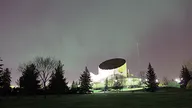The Visible Planets
Mercury is found very low above the east-northeastern horizon at the start of the month, but it will be difficult to see with the sky brightening before sunrise. If you use binoculars or a small telescope, then you may see Mercury very near the brighter planet Jupiter before sunrise on June 4. The two planets will be separated by a meager 7 minutes of arc. On June 5 look for the very shallow waning crescent Moon above both Mercury and Jupiter. Binoculars will greatly assist in viewing this conjunction of the Moon with the planets Mercury and Jupiter. At mid-month Mercury will be at superior conjunction. By the end of the month, Mercury slowly emerges out of the Sun’s setting glow appearing low in our west-northwestern sky.
Venus is not visible this month. It will be at its point of superior conjunction on June 4.
Mars rises along the east-northeast horizon around 3:00 a.m. local time and then is found about 14° above the eastern horizon by sunrise at the start of the month. By the end of the month, Mars rises along the east-northeast horizon at around 2:00 a.m. local time, and then can be found about 24° above the eastern horizon at sunrise. Mars starts the month in the zodiac constellation of Pisces, the fish, but slowly moves into the zodiac constellation of Aries, the ram, by June 10. On June 2, look for Mars just to the left of the waning crescent Moon and then to the right of the waning crescent Moon on the morning of June 3.
Jupiter is found rising along the east-northeast horizon at around 5:00 a.m. at the start of the month and then at around 3:30 p.m. at the end of the month. As we move through the month, Jupiter gains elevation above the eastern horizon appearing about 13° above the eastern horizon before sunrise at the end of the month. Jupiter will be situated amongst the stars of the zodiac constellation of Taurus, the bull, and can be seen near the bright star, Aldebaran. Before sunrise on June 5, look for Jupiter just below a very shallow waning crescent Moon above the east-northeastern horizon.
Saturn rises along the east-southeast horizon at around 2:30 a.m. early in the month and near 1:00 a.m. by the end of the month. It can be found over 25° above the southeastern horizon by the time of sunrise. Saturn spends the entire month within the zodiac constellation of Aquarius, the water bearer, becoming stationary on June 30 before beginning its retrograde motion. On June 27 look for Saturn just above and to the left of the waning gibbous Moon. When viewed through a telescope, Saturn’s rings are becoming quite shallow with not much of a tilt to them.
Moon Phases
June 6 New Moon
June 13 First Quarter Moon
June 21 Full Moon (The Strawberry Moon or the Trees Fully Leafed Moon)
June 28 Last Quarter Moon
Special Events
International Space Station (ISS) Observable Passes
During the month of June there are only four early morning passes of the ISS, from June 26 to June 30. Exact times of these passages for your location can be found by visiting the website http://www.heavens-above.com or by using satellite tracking smart phone apps like Sputnik or Spot-the-Station.
Noctilucent Clouds
From June to late July, noctilucent clouds can be seen from the Edmonton area. Look for these extremely high, pearly blue clouds, in the northern sky.
June 10 Royal Astronomical Society of Canada (RASC) Edmonton Centre meeting
Live in the Zeidler Dome at TWOSE and presented virtually through Zoom.
7:30 p.m. – 9:30 p.m.
Free for anyone to attend.
See http://www.edmontonrasc.com for more details.
June 14 Mercury at superior conjunction
June 20 Summer Solstice takes place at exactly 2:51 p.m. MDT.
June 30 Asteroid Day
Saturn stationary





